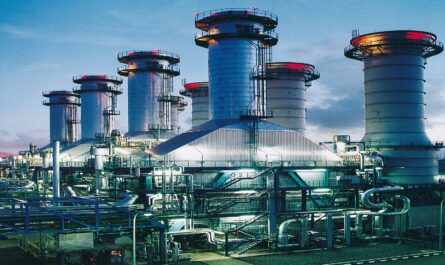What are Vapor Recovery Units?
A vapor recovery unit (VRU), also known as a vapor recovery system (VRS), is a device used to recover hydrocarbon vapors from the vent lines of above-ground or below-ground tanks at petroleum product terminals, bulk plants, and service stations during loading and unloading operations. Vapor recovery reduces volatile organic compound (VOC) emissions from tank vent lines and collects hydrocarbon vapors that would otherwise be released into the atmosphere.
How Vapor Recovery Units Work
VRUs come in a variety of configurations depending on the application and types of vapors being recovered. However, most utilize thermal or catalytic oxidation as the primary control technology. During loading and unloading events, hydrocarbon vapors are displaced from storage tanks by incoming or outgoing liquid product. The vapors travel up vent lines connected to each storage tank. A Vapor Recovery Units uses combustion to convert the hydrocarbon gases into less harmful emissions like carbon dioxide and water vapor before being released.
Thermal or catalytic oxidation works by feeding the hydrocarbon vapors into a combustion chamber where they are ignited at high temperatures ranging from 1,500°F to 1,800°F. The combustion process fully oxidizes the hydrocarbon molecules into carbon dioxide, water vapor, and other trace compounds. For thermal oxidation, a burner is used to achieve the necessary temperature. Catalytic oxidation uses a catalyst such as platinum to facilitate combustion at lower temperatures of approximately 600°F to 750°F. Both methods result in over 98% conversion efficiency to control VOC emissions.
Recovering Vapors at Petroleum Terminals
At petroleum terminals like gasoline loading racks, a vapor recovery unit collects hydrocarbon vapors displaced during storage tank loading operations. As liquid product enters the tank through the loading arm, it displaces vapors in the ullage space above the liquid level. These vapors exit the tank through vapor return lines connected to the vent pipes.
The VRU uses vapor-liquid separating technology like absorption, adsorption, or condensation to separate hydrocarbons from the vapor exhaust stream. It then routes the collected vapors back through dedicated vapor return lines on the loading arm and nozzles where the vapors are returned to the gasoline truck or rail car being loaded. This reduces emissions that would otherwise escape into the air. Any remaining exhaust vapors from the VRU are then processed using thermal or catalytic oxidation for final control.
Recovering Vapors at Gas Stations
At gas stations, vapor recovery occurs during fueling operations when vehicles are filled at the pumps. As liquid gasoline enters the vehicle fuel tank, it displaces gasoline vapors that would normally exit through the tank vent. Stage I vapor recovery requires a balance system between the underground storage tank and the fuel dispenser. It uses adsorption units to collect the displaced vapors during fuel deliveries into the underground tanks.
Stage II vapor recovery focuses on capturing vehicle fuel tank vapors during refueling. It uses a vapor return line that connects from the fill nozzle back to the gas station’s underground storage tanks. A vacuum assist system helps draw the hydrocarbon vapors from the vehicle’s fuel tank into the nozzle and through the vapor return line where they are returned to the station’s tanks, all without releasing emissions to the air. Some Stage II systems also employ vapor collection and processing using thermal or catalytic oxidation units for enhanced vapor recovery.
Benefits of vapor recovery units
Reduces harmful air pollutants – By recovering up to 95-98% of hydrocarbon vapors that would otherwise escape as air pollution, VRUs help reduce emissions of VOCs, toxic air contaminants, and greenhouse gases like methane. This decreases ozone formation and health risks from poor air quality.
Complies with environmental regulations – Vapor recovery is mandated at gasoline stations, bulk terminals, and other petroleum product transfer facilities to comply with stringent state and federal Clean Air Act regulations focused on lowering VOC emissions. VRUs provide an effective solution for regulated facilities.
Conserves product and resources – Capturing vapors during loading and unloading operations reduces product losses through evaporation and fugitive emissions. Recovering vapors returns uncombusted hydrocarbons to the storage tanks where they remain part of the transferred volume. This increases efficiency.
Ongoing operation and maintenance
Like any combustion system, vapor recovery units require routine operation and maintenance according to manufacturer specifications to ensure optimal performance over the long run. Most critical among these are:
– Regular inspections and calibration of monitoring equipment like flow meters, pressure/vacuum sensors, and electronic consoles.
– Weekly physical inspections for leaks, damage, or deterioration of equipment.
– Monthly testing of burners, pilots, and ignition sources.
– Semi-annual replacement of catalyst packs in catalytic oxidation units.
– Annual checking and adjusting of gas/air mixture ratios.
– Annual tuning of combustion temperature, typically via adjustment of burner output.
– Record keeping of all inspections, repairs, and parameter readings per permit requirements.
With scheduled care and maintenance, vapor recovery units can reliably process hydrocarbon vapors for 15-20 years or more, safely controlling emissions from petroleum loading/unloading and fulfilling their important environmental protection role. Proper operation directly impacts regulatory compliance and emission reductions.
*Note:
1. Source: Coherent Market Insights, Public sources, Desk research
2. We have leveraged AI tools to mine information and compile it



